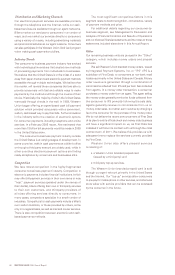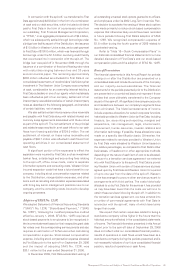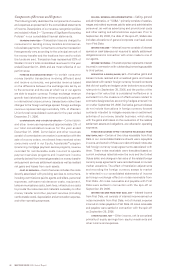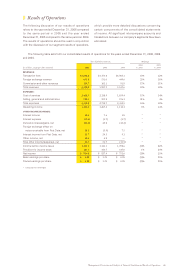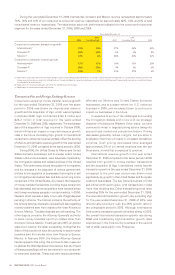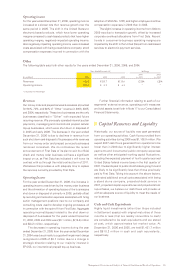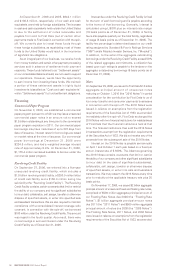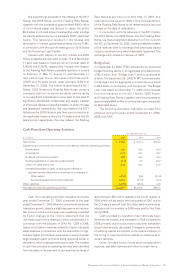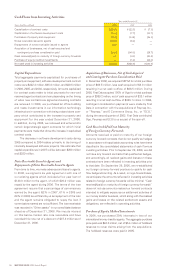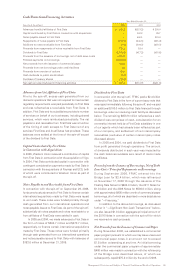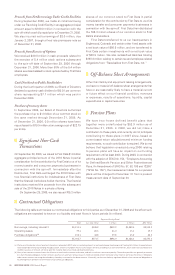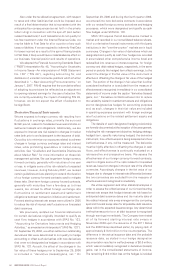Western Union 2006 Annual Report Download - page 50
Download and view the complete annual report
Please find page 50 of the 2006 Western Union annual report below. You can navigate through the pages in the report by either clicking on the pages listed below, or by using the keyword search tool below to find specific information within the annual report.
WESTERN UNION 2006 Annual Report 48
Transaction Fees and Foreign Exchange Revenue
Consumer-to-consumer money transfer revenue growth
for the year ended December 31, 2006 over the same
period in 2005 was driven by international revenue
growth and the acquisition of Vigo, which was completed
in October 2005. Vigo contributed $140.5 million and
$24.2 million in total revenue for the years ended
December 31, 2006 and 2005, respectively. The anniversary
date of the acquisition of Vigo occurred in October 2006,
which will have an impact on reported revenue growth
rates in the future. Excluding Vigo, growth in international
consumer-to-consumer revenue partially offset the slowing
of Mexico and domestic revenue growth in the year ended
December 31, 2006 compared to the same period in 2005.
During 2006, the United States to Mexico and United
States domestic businesses, and to a lesser extent United
States outbound businesses, were adversely impacted by
the immigration debate and related activities in the United
States. This controversy around the subject of immigration
and the changes in the approach of various government
entities to the regulation of businesses that employ or sell
to immigrants has created fear and distrust among some
consumers in the United States. As a result, the frequency
of money transfer transactions involving these consumers
has decreased and some competitors have lowered prices
and foreign exchange spreads in certain markets. In 2006,
Western Union was also a party in two sets of legal disputes
pending in Arizona. The first set concerns the authority of
the Arizona Attorney General to request bulk data regarding
money transfers sent from states other than Arizona to
Sonora, Mexico. The data disputes are still pending. The
other dispute concerns the Attorney General’s authority
to seize money transfers sent from states other than
Arizona to Sonora, Mexico. In early January 2007, an Arizona
state court ruled on the latter proceeding, finding that the
State of Arizona did not have the authority to seize money
transfers sent from states other than Arizona to Sonora,
Mexico. In February 2007, the Arizona Attorney General
filed an appeal to this ruling. We continue to take measures
to address the data disputes and we believe that any impact
of these proceedings will not be material to our consumer-
to-consumer business. These and other issues adversely
affected our Mexico and United States domestic
businesses, and to a lesser extent our U.S. outbound
business in 2006, and we expect them to continue to
impact our businesses in the future.
In response to some of the challenges surrounding
the immigration debate and in line with our strategic
objective of building the Western Union brand, we have
continued to invest in targeted pricing actions taking into
account local market and competitive factors. Pricing
decreases generally reduce margins, but are done in
anticipation that they will result in increased transaction
volumes. Such pricing decreases have averaged
approximately 3% of our annual revenues over the last
three years, a trend that is expected to continue.
International revenue growth in the year ended
December 31, 2006 compared to the same period in 2005
resulted from growth in money transfer transactions
and the acquisition of Vigo. International money transfer
transaction growth in the year ended December 31, 2006
compared to the prior year period was driven most
significantly by growth in the United States and European
outbound businesses. The key inbound markets of India
and China continued to grow, with transactions in India
more than doubling and China transaction growth rates
exceeding 35% for the year ended December 31, 2006.
The international transaction growth rate excluding Vigo
for the year ended December 31, 2006 of 24% was
directionally consistent with the 26% growth rate for
the comparable period in 2005. Although international
intra-country transaction growth remained strong in 2006,
the overall international transaction growth rate during
2006 was impacted by high transaction growth rates
experienced in the intra-country business in the second
half of 2005, particularly in the Philippines.
During the year ended December 31, 2006 international, domestic and Mexico revenue represented approximately
74%, 16% and 10% of our consumer-to-consumer revenue, respectively (or approximately 62%, 14% and 8% of total
consolidated revenue, respectively). The table below sets forth performance indicators for the consumer-to-consumer
segment for the years ended December 31, 2006, 2005 and 2004.
Years Ended December 31,
2006 2005
2006 (excluding Vigo) 2005 (excluding Vigo) 2004
Consumer-to-consumer transaction growth:
International
(a) 29% 24%
27% 26% 24%
Domestic
(b) (1)% (2)%
5% 5% 8%
Mexico
(c) 35% 6%
28% 21% 16%
Consumer-to-consumer revenue growth:
International
(a) 17% 15%
16% 15% 21%
Domestic
(b) (3)% (3)%
4% 4% 8%
Mexico
(c) 29% 7%
33% 27% 6%
(a) Represents transactions between and within foreign countries (excluding Canada and Mexico), transactions originated in the United States or Canada paid in foreign countries and
foreign country transactions paid in the United States or Canada. Excludes all transactions between or within the United States and Canada and all transactions to and from Mexico
as reflected in (b) and (c) below.
(b) Represents all transactions between and within the United States and Canada.
(c) Represents all transactions to and from Mexico.


